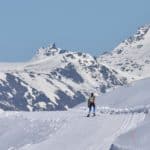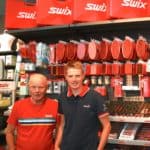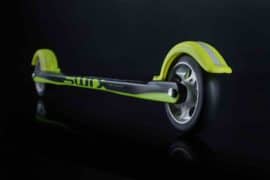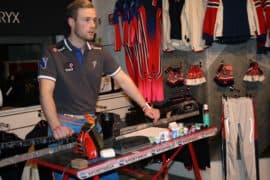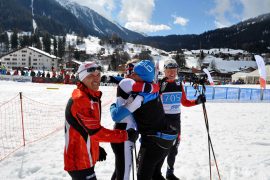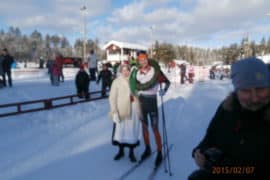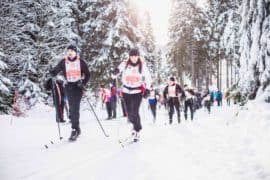This post is also available in:
 Norsk bokmål
Norsk bokmål

Together with Trondheim’s leading cross-country skiing specialist sportsbua, xc-marathon.com tested skin skis, whereas several of the year’s (2017/-18) most popular and best models from Fischer, Atomic and Rossignol were tested. We put the most emphasis on grip, the skis behavior and it´s properties uphill and on flat stretches.
Test venue: Granåsen Stadion Trondheim, Norway
We tested the skin skis at Granåsen Stadium in Trondheim. at 09.00, -12 degrees (celcius) and older natural snow, possibly with elements of artificial snow. We thought this provided good conditions for testing the skis because the cold, rounded snow grains would not provide optimum conditions for the skin skis and thus would give challenges, but also opportunities to excel for the good skis.
Receive newsletters from xc-marathon.com with more articles like this one, subscribe here.
Testers: Pro and Amateur
We were two individuals testing the skis – a professional who knows the skiing and gripping issues in depth, and an amateur and hobby exerciser that takes this group of skiers´ expectations and experiences under consideration. The pro was Andreas Helgemo, chief of waxing for Team Veidekke in mid-Norway, and cross-country skiing expert at Sportsbua in Trondheim. The hobby exerciser was the xc-marathonist and editor of xc-marathon.com, Steffen R. Larssen.

Emphasis was placed on the fact that this is a test of skin skis, and the skin components importance of the skiing experience is emphasized more than general glide, etc.
Initially we can say that mainly all the skis that were tested are very good skin skis. Yours trulys experiences with skin skis stems from 2-3 years older, and slightly less sophisticated models, and there was a big difference in quality compared to the ones tested for this article. The drag I have previously experienced (but not more than acceptable) both upward, on flat stretches and (somewhat) downwards were eliminated by these models. The main impression was that the skis thus could be regarded as ordinary, well prepared classic skis. Therefore, we do not select any “winner” or “loser”, but still choose each of our personal favourites. We also describe various experiences and qualities of what is basically perceived as very good skin skis.
The skis that were tested:
Top models:
Atomic Redster C9
Rossignol R-Skin Race
Fischer Twin Skin Carbon
Models directly below the top models:
Rossignol R-Skin
Fischer Twin Skin Race
Atomic Redster C9:
My, the hobby exerciser´s experience of Atomic Redster C9 was that it was very immediate and consistent. In terms of the actual skiing structure and its characteristics, Redster C9 was a steady, slightly stiff ski that doesnt make much out of itself, for better and worse. It

is a very light and almost a little ´shy´ ski that doesn´t give the skier any surprises. At the same time it feels steady.
In our test round we started immediately on a climb out from the stadium, and this is approx. 300 meter long. The Redster C9 skis worked perfectly in this climb without a single slip from the kick.
Andreas, the pro from Sportsbua during our round highlighted that the Redster skis are also easy to bring forward (i.e. they dno´t drag, or create friction with the surface when you put the foot down to glide, after the kick).
No slipping, and no drag is in many ways the formula one wants from skin skis and thus Atomic Redster C9 is giving a very good impression in this part of the track.
At the top of the hill we get the opportunity, on a subsequent flat stretch, to test how the skis react to double poling. Yours truly does not experience any problems with the ski´s behavior during the poling. With my power and my efforts I stand well and balanced on the skis and experience no drag or other disturbances. Andreas believes, however, that since these skis are stiff and do not “flex” that much vertically they may have a slightly smaller room for pressure towards the ground from a hard double poling skier and may drag a little bit.
Atomic Redster is perceived simply as a normally, well waxed, good racing ski.
Rossignol R-Skin Race
Rossignol R-Skin Race instantly showed off its lively side. They have a form of clear response to the pressure of the foot in the kick and show off a presence through to following or adjusting to small variations in the snow and the track. It is, of course, different

opinions as if this is perceived as important, but personally I prefer this trait, and the Rossignols R-skin Race thus make a very good first impression.
Upwards the same 300 feet long hill out from the Granåsen Stadium, the R-Skin Race is worked very well, and for the hobby exerciser it worked simply very well, also considering the forward glide of the ski. Also with this ski, on can not really notive that it is really a skin ski. Neither did we do that during the double poling stretches.
Andreas from Sportsbua experienced the R-Skin Race was a little heavy to push forward in the track, and a little soft to double pole with. In the professional terminology he also thought it “wanders” a little more vertically (softer “suspension”), because it is a little more flexible and vivid, but he also believes as the hobby exerciser that the R-Skin Race gives a good feeling with the surface.
Fischer Twin Skin Carbon
It was just me, the hobby exerciser, that tested Fischer’s top Model (Twin Skin Carbon) with skin. Regarding the Twin Skin Carbon skis, one could easily recognise Fischer’s flexible and dynamic features from other models of

the same brand; the experience from before, that the ski almost winds itself above and around the rough edges, snow lumps, etc. in the track and thus provides a very soft and constant propulsion. This is in my opinion what perhaps primarily separates Fischer from other ski brands.
With Fischer Twin Skin Carbon, it was somewhat more difficult to gain grip in the uphill. Thus, as an effect it was also a bit more difficult to keep pace and momentum, and the performance of the ski suffered slightly from that. Andreas from Sportsbua was instantly aware and correctly pointed out that yours truly showed somehow an imperfect technique (slightly small lateral movement of the hips) and the fact that Fischer’s skin skis has a smaller surface area with skins under the skis, thus makes them a little more demanding for the skier. Andreas also thought that the Fischer skis did not have quite the same grip properties as Atomic and Rossignol under such cold conditions. In other words it is likely that the slightly missing grip properties are more due to the skier, and some to the temperature, than the skis.
On the flats, during the double poling, the Fischer skis was experienced as very good, and this is where the Fishchers flexibility and dynamism, provides a better skiing experience.
Fischer Twin Skin Race
Only Andreas from Sportsbua tested these. His evaluation: A more forgiving ski than the Twin Skin Carbon. Still a good performance

when it comes to pushing the ski forward, as their ´big brother´, but also a little easier to create good grip with. It has a skin that is 4 cm longer than Twin Skin
Carbon, which is creating a larger area with the skin that meets the surface of the snow. Great training skis for the ones that is not perfectly skilled technically, while the skilled ones technically would choose a carbon ski because of it´s properties.
Rossignol R-Skin
Rossignols R-Skin (i.e. without the ´ Race ´ prefix in its name and properties) was perceived, as expected, in many ways like the ´ Race ´-edition. They were flexible and lively, but with a little easier opportunity to get good contact and grip with the surface with the skin; If I tried to exaggerate my movements vertically during the double poling, ie. ´jump´ a little bit up and

forward, the skis would drag slightly/have some friction with the surface. Andreas from Sportsbua thinks for the same reason that R-skin is a bit heavier to push forward than the R-skin Race edition.
Maneuvering, downhills
In the slopes down towards the stadium, none of the skis differed from each other, although this was not the main focus of this test. In a ski stadium there are sharp and pronounced turns. It provides, with similar sharp and decisive maneuvers, the ability to check for instability in this type of terrain. But none of the skis we tested showed any such weaknesses, inside or outside the track. What one also could possibly notice is the chance of skin skis dragging/create friction downwards, especially outside the track, but no such effect was observed for any of the skis.

Our favourites
We believe that skis and properties are associated with personal preferences and techniques. We select one model each
that was our favorite that day. The pro Andreas chooses Atomic Redster C9 this day due to the total perception of grip, forward glide and poling properties. The hobby exerciser Steffen chooses Rossignol R-Skin Race because it was so similar to regular well waxed skis, at the same time it had liveliness and response, which I personally think strengthens the skiing experience.
XC-marathon.com thank the Sportsbua in Trondheim for benevolently setting up for this test with skis and expertise.


